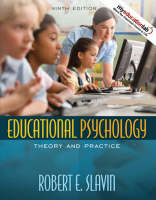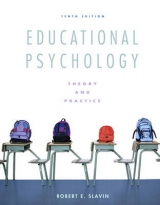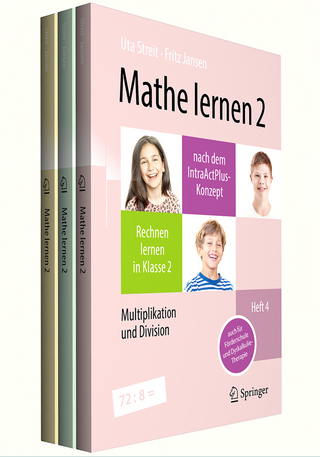
Educational Psychology
Pearson (Verlag)
978-0-205-59200-5 (ISBN)
- Titel erscheint in neuer Auflage
- Artikel merken
This edition includes a new focus on reflection, new cases, sections on brain research, programs for language minority students, technology, No Child Left Behind, and after school and summer school programs. It contains new critiques of assessment and accountability strategies and a substantially updated treatment of programming for students with special needs.
Each chapter concludes with “Chapter Summary,” “Key Terms,” and “Self-Assessment: Preparing for Licensure.”
1. Educational Psychology: A Foundation for Teaching.
What Makes a Good Teacher?
Knowing the Subject Matters (but So Does Teaching Skill)
Mastering the Teaching Skills
Can Good Teaching Be Taught?
The Intentional Teacher
Personal Reflection: Adapting
What Is the Role of Research in Educational Psychology?
The Goal of Research in Educational Psychology
The Value of Research in Educational Psychology to the Teacher
Teaching as Decision Making
Theory into Practice: Teaching as Decision Making
Research + Common Sense = Effective Teaching
Research on Effective Programs
Impact of Research on Educational Practice
Theory into Practice: How to Be an Intelligent Consumer of Educational Psychology Research
What Research Methods Are Used in Educational Psychology?
Experiments
Correlational Studies
Descriptive Research
Personal Reflection: Using Research to Inform Teaching
Action Research
How Can I Become an Intentional Teacher?
Teacher Certification
Beyond Certification
The Intentional Teacher: Choosing a New Curriculum
2. Theories of Development.
What Are Some Views of Human Development?
Aspects of Development
Issues of Development
How Did Piaget View Cognitive Development?
How Development Occurs
Piaget's Stages of Development
Personal Reflection: Egocentrism in Action
How Is Piaget's Work Viewed Today?
Criticisms and Revisions of Piaget's Theory
Theory into Practice: Educational Implications of Piaget’s Theory
Neo-Piagetian and Information-Processing Views of Development
How Did Vygotsky View Cognitive Development?
How Development Occurs
Applications of Vygotskian Theory in Teaching
Theory into Practice: Classroom Applications of Vygotsky’s Theory
How Did Erikson View Personal and Social Development?
Stages of Psychosocial Development
Implications and Criticisms of Erikson's Theory
What Are Some Theories of Moral Development?
Piaget's Theory of Moral Development
Kohlberg's Stages of Moral Reasoning
Theory into Practice: Fostering Moral Development in the Classroom
Criticisms of Kohlberg's Theory
Personal Reflection: Developing Character
Teaching Dilemma: Using Moral Reasoning
The Intentional Teacher: Using What You Know About Human Development to Improve Teaching and Learning
3. Development during Childhood and Adolescence.
How Do Children Develop During the Preschool Years?
Physical Development in Early Childhood
Language Acquisition
Personal Reflection: Understanding Development
Teaching Dilemma: Adapting Instruction
Theory into Practice: Promoting Language Development in Young Children
Socioemotional Development
What Kinds of Early Childhood Education Programs Exist?
Day-Care Programs
Preschools
Compensatory Preschool Programs
Early Intervention
Kindergarten Programs
Developmentally Appropriate Practice
How Do Children Develop During the Elementary Years?
Physical Development during Middle Childhood
Cognitive Abilities
Socioemotional Development in Middle Childhood
Theory into Practice: Promoting the Development of Self-Esteem
Theory into Practice: Helping Children Develop Social Skills
How Do Children Develop During the Middle School and High School Years?
Physical Development during Adolescence
Cognitive Development
Characteristics of Hypothetical-Deductive Reasoning
Theory Into Practice: Promoting Formal Operational Thought
Socioemotional Development in Adolescence
Identity Development
Personal Reflection: Coping with Change
James Marcia's Four Identity Statuses
Self-Concept and Self-Esteem
Social Relationships
Emotional Development
Problems of Adolescence
Theory into Practice: Providing Developmental Assets for Adolescents
The Intentional Teacher: Using What You Know About Early Childhood, Middle Childhood, and Adolescent Students to Promote Teaching and Learning
4. Student Diversity.
What Is the Impact of Culture on Teaching and Learning?
How Does Socioeconomic Status Affect Student Achievement?
The Role of Child-Rearing Practices
The Link between Income and Summer Learning
The Role of Schools As Middle-Class Institutions
School and Community Factors
School, Family, and Community Partnerships
Theory Into Practice: Parent Involvement
Is the Low Achievement of Children from Low-Income Groups Inevitable?
Implications for Teachers
How Do Ethnicity and Race Affect Students' School Experiences?
Racial and Ethnic Composition of the United States
Academic Achievement of Minority-Group Students
Why Have Minority-Group Students Lagged in Achievement?
Teaching Dilemma: Meeting Resistance
Effects of School Desegregation
Personal Reflection: Being Sensitive to Race
Theory into Practice: Teaching in a Culturally Diverse School
How Do Language Differences and Bilingual Programs Affect Student Achievement?
Bilingual Education
Theory into Practice: Teaching English Language Learners
What Is Multicultural Education?
Dimensions of Multicultural Education
How Do Gender and Gender Bias Affect Students' School Experiences?
Do Males and Females Think and Learn Differently?
Sex-Role Stereotyping and Gender Bias
Theory into Practice: Avoiding Gender Bias in Teaching
How Do Students Differ in Intelligence and Learning Styles?
Definitions of Intelligence
Theory into Practice: Multiple Intelligences
Origins of Intelligence
Theories of Learning Styles
Aptitude-Treatment Interactions
Personal Reflection: Understanding Diverse Thinkers
The Intentional Teacher: Using What You Know About Student Diversity to Improve Teaching and Learning
5. Behavioral and Social Theories of Learning.
What Is Learning?
What Behavioral Learning Theories Have Evolved?
Pavlov: Classical Conditioning
Thorndike: The Law of Effect
Skinner: Operant Conditioning
What Are Some Principles of Behavioral Learning?
The Role of Consequences
Reinforcers
Theory into Practice: Classroom Uses of Reinforcement
Intrinsic and Extrinsic Reinforcers
Theory into Practice: Practical Reinforcers
Punishers
Immediacy of Consequences
Personal Reflection: Modifying Behavior
Shaping
Extinction
Schedules of Reinforcement
Teaching Dilemma: Dealing with Behavior Problems
Maintenance
The Role of Antecedents
How Has Social Learning Theory Contributed to Our Understanding of Human Learning?
Bandura: Modeling and Observational Learning
Theory into Practice: Observational Learning
Meichenbaum's Model of Self-Regulated Learning
Personal Reflection: Using Different Styles
Strengths and Limitations of Behavioral Learning Theories
The Intentional Teacher: Using What You Know About Behavioral and Social Theories of Learning to Improve Teaching and Learning
6. Cognitive Theories of Learning.
What Is an Information-Processing Model?
Sensory Register
Short-Term or Working Memory
Long-Term Memory
Factors That Enhance Long-Term Memory
Other Information-Processing Models
Research on the Brain
What Causes People to Remember or Forget?
Forgetting and Remembering
Theory into Practice: Reducing Retroactive Inhibition
Practice
How Can Memory Strategies Be Taught?
Verbal Learning
Paired-Associate Learning
Theory Into Practice: Keyword Mnemonics
Serial and Free-Recall Learning
What Makes Information Meaningful?
Rote versus Meaningful Learning
Schema Theory
Teaching Dilemma: Differing Approaches
How Do Metacognitive Skills Help Students Learn?
What Study Strategies Help Students Learn?
Note-Taking
Underlining
Summarizing
Outlining and Mapping
Outlining and Mapping
The PQ4R Method
Personal Reflection: Defining “Effective”
Theory into Practice: Teaching the PQ4R Method
How Do Cognitive Teaching Strategies Help Students Learn?
Making Learning Relevant and Activating Prior Knowledge
Organizing Information
The Intentional Teacher: Using What You Know About Cognitive Theories of Learning to Improve Teaching and Learning
7. The Effective Lesson.
Personal Reflection: Balancing Instruction
What Is Direct Instruction?
How Is a Direct Instruction Lesson Taught?
State Learning Objectives
Theory into Practice: Planning a Lesson
Orient Students to the Lesson
Theory into Practice: Communicating Objectives to Students
Review Prerequisites
Present New Material
Conduct Learning Probes
Provide Independent Practice
Assess Performance and Provide Feedback
Provide Distributed Practice and Review
Teaching Dilemma: Designing Lessons
What Does Research on Direct Instruction Methods Suggest?
Advantages and Limitations of Direct Instruction
How Do Students Learn and Transfer Concepts?
Concept Learning and Teaching
Teaching for Transfer of Learning
How Are Discussions Used in Instruction?
Subjective and Controversial Topics
Difficult and Novel Concepts
Affective Objectives
Whole-Class Discussions
Small-Group Discussions
The Intentional Teacher: Using What You Know About Direct Instruction to Improve Teaching and Learning
8. Student-Center and Constructivist Approaches to Instruction.
What Is the Constructivist View of Learning?
Historical Roots of Constructivism
Top-Down Processing
Cooperative Learning
Discovery Learning
Self-Regulated Learning
Teaching Dilemma: Developing Self-Regulating Techniques
Scaffolding
APA’s Learner-Centered Psychological Principles
Constructivist Methods in the Content Areas
Theory into Practice: Introducing Reciprocal Teaching
Research on Constructivist Methods
How Is Cooperative Learning Used in Instruction?
Cooperative Learning Methods
Theory into Practice: Student Teams-Achievement Divisions (STAD)
Research on Cooperative Learning
Personal Reflection: Working Together
How Are Problem-Solving and Thinking Skills Taught?
The Problem-Solving Process
Obstacles to Problem Solving
Teaching Creative Problem Solving
Teaching Thinking Skills
Critical Thinking
The Intentional Teacher: Using What You Know About Student-Centered and Constructivist Approaches to Improve Teaching and Learning
9. Accommodating Instruction to Meet Individual Needs.
What Are Elements of Effective Instruction Beyond a Good Lesson?
Carroll’s Model of School Learning and QAIT
How Are Students Grouped to Accommodate Achievement Differences?
Between-Class Ability Grouping
Untracking
Regrouping for Reading and Mathematics
Nongraded (Cross-Age Grouping) Elementary Schools
Within-Class Ability Grouping
What Is Mastery Learning?
Forms of Mastery Learning
Theory into Practice: Applying the Principles of Mastery Learning
Research on Mastery Learning
What Are Some Ways of Individualizing Instruction?
Peer Tutoring
Adult Tutoring
Theory into Practice: Effectively Using Tutoring Methods to Meet Individual Needs
How Is Technology Used in Education?
Technology for Instruction
Technology for Learning
Personal Reflection: Computers in Education
Technology for Administration
Research on Computer-Based Instruction
Cutting Edge Educational Technologies
Teaching Dilemma: Should Computers Be in Labs or Classrooms?
What Educational Programs Exist for Students Placed at Risk?
Compensatory Education Programs
No Child Left Behind
Early Intervention Programs
After School and Summer Programs
The Intentional Teacher: Using What You Know About Accommodating Instruction to Meet Individual Needs
10. Motivating Students to Learn.
What Is Motivation?
What Are Some Theories of Motivation?
Motivation and Behavioral Learning Theory
Motivation and Human Needs
Motivation and Attribution Theory
Theory into Practice: Giving Students Motivating Feedback
Motivation and Self-Regulated Learning
Motivation and Expectancy Theory
How Can Achievement Motivation Be Enhanced?
Motivation and Goal Orientations
Learned Helplessness and Attribution Training
Theory into Practice: Helping Students Overcome Learned Helplessness
Teacher Expectations and Achievement
Teaching Dilemma: Expectations
Anxiety and Achievement
How Can Teachers Increase Students’ Motivation to Learn?
Intrinsic and Extrinsic Motivation
How Can Teachers Enhance Intrinsic Motivation?
Teaching Dilemma: Adapting Strategies
Principles for Providing Extrinsic Incentives to Learn
How Can Teachers Reward Performance, Effort, and Improvement?
Using Praise Effectively
Teaching Students to Praise Themselves
Using Grades As Incentives
Incentive Systems Based on Goal Structure
The Intentional Teacher: Using What You Know About Motivation to Improve Teaching and Learning
11. Effective Learning Environments.
What Is an Effective Learning Environment?
What Is the Impact of Time on Learning?
Using Allocated Time for Instruction
Using Engaged Time Effectively
Personal Reflection: Maintaining Control
Can Time On-Task Be Too High?
Classroom Management in the Student-Centered Classroom
What Practices Contribute to Effective Classroom Management?
Starting Out the Year Right
Setting Class Rules
Teaching Dilemma: Rules of the Room
What Are Some Strategies for Managing Routine Misbehavior?
The Principle of Least Intervention
Prevention
Nonverbal Cues
Praising Behavior That Is Incompatible with Misbehavior
Praising Other Students
Verbal Reminders
Repeated Reminders
Applying Consequences
How Is Applied Behavior Analysis Used to Manage More Serious Behavior Problems?
How Student Misbehavior Is Maintained
Principles of Applied Behavior Analysis
Applied Behavior Analysis Programs
Theory into Practice: Using a Daily Report Card
Theory into Practice: Establishing a Group Contingency Program
Ethics of Behavioral Methods
How Can Serious Behaviors Problems Be Prevented?
Preventive Programs
Identifying Causes of Misbehavior
Enforcing Rules and Practices
Enforcing School Attendance
Check and Connect
Avoiding Tracking
Practicing Intervention
Requesting Family Involvement
Using Peer Mediation
Judiciously Applying Consequences
The Intentional Teacher: Using What You Know About Effective Learning Environments to Improve Teaching and Learning
12. Learners with Exceptionalities.
Who Are Learners with Exceptionalities?
“People-First” Language
Types of Exceptionalities and the Numbers of Student Served
Students with Mental Retardation
Theory into Practice: Teaching Adaptive Behavior Skills
Student with Learning Disabilities
Theory into Practice: Teaching Students with Learning Disabilities
Students with Attention Deficit Hyperactivity Disorder
Theory into Practice: Students with ADHD: The Role of the Teacher
Students with Speech or Language Impairments
Students with Emotional and Behavioral Disorders
Students with Sensory, Physical, and Health Impairments
Students Who Are Gifted and Talented
What Is Special Education?
Public Law 94-142 and IDEA
An Array of Special Education Services
Teaching Dilemma: Referring a Student
Theory into Practice: Preparing IEPs
What Are Mainstreaming and Inclusion?
Research on Inclusion
Personal Reflection: The Struggle Over Inclusion
Adapting Instruction
Theory into Practice: Adapting Instruction for Students with Special Needs
Teaching Learning Strategies and Metacognitive Awareness
Prevention and Early Intervention
Computers and Students with Disabilities
Buddy Systems and Peer Tutoring
Special-Education Teams
Teaching Dilemma: Finding What Works
Social Integration of Students with Disabilities
The Intentional Teacher: Using What You Know About Learners with Exceptionalities to Improve Teaching and Learning
13. Assessing and Grading Student Learning.
What Are Instructional Objectives and How Are They Used?
Planning Lesson Objectives
Theory into Practice: Planning Courses, Units, and Lessons
Linking Objectives and Assessment
Using Taxonomies of Instructional Objectives
Research on Instructional Objectives
Why Is Evaluation Important?
Evaluation As Feedback
Evaluation As Information
Evaluation As Incentive
How Is Student Learning Evaluated?
Formative and Summative Evaluations
Norm-Referenced and Criterion-Referenced Evaluations
Matching Evaluation Strategies with Goals
How Are Tests Constructed?
Principles of Achievement Testing
Theory Into Practice: Making Assessments Fair
Using a Table of Specifications
Writing Selected-Response Test Items
Theory into Practice: Writing Multiple-Choice Tests
Writing Constructed-Response Items
Writing and Evaluating Essay Tests
Theory Into Practice: Detecting Bluffing in Students’ Essays
Writing and Evaluating Problem-Solving Items
Theory into Practice: Peer Evaluations
What Are Portfolio and Performance Assessments?
Portfolio Assessment
Theory into Practice: Using Portfolios in the Classroom
Performance Assessment
How Well Do Performance Assessments Work?
Scoring Rubrics for Performance Assessments
How Are Grades Determined?
Establishing Grading Criteria
Assigning Letter Grades
Teaching Dilemma: Establishing a Grading System
Performance Grading
Other Alternative Grading Systems
Assigning Report Card Grades
Personal Reflection: Assigning Grades
The Intentional Teacher: Using What You Know About Assessing and Grading Student Learning to Improve Teaching and Learning
14. Standardized Tests.
What Are Standardized Tests and How Are They Used?
Selection and Placement
Diagnosis
Evaluation
School Improvement
Accountability
Theory into Practice: Teaching Test-Taking Skills
Personal Reflection: Mixed Messages
What Types of Standardized Tests Are Given?
Aptitude Tests
Norm-Referenced Achievement Tests
Criterion-Referenced Achievement Tests
Standard Setting
How Are Standardized Tests Interpreted?
Percentile Scores
Grade-Equivalent Scores
Standard Scores
Theory into Practice: Interpreting Standardized Test Scores
What Are Some Issues Concerning Standardized and Classroom Testing?
Test Validity
Test Reliability
Test Bias
Computer Test Administration
Teaching Dilemma: Dealing with High-Stakes Testing
The Intentional Teacher: Using What You Know About Standardized Tests to Improve Teaching and Learning
| Erscheint lt. Verlag | 2.5.2008 |
|---|---|
| Sprache | englisch |
| Maße | 216 x 276 mm |
| Gewicht | 1200 g |
| Themenwelt | Geisteswissenschaften ► Psychologie ► Pädagogische Psychologie |
| ISBN-10 | 0-205-59200-7 / 0205592007 |
| ISBN-13 | 978-0-205-59200-5 / 9780205592005 |
| Zustand | Neuware |
| Haben Sie eine Frage zum Produkt? |
aus dem Bereich



